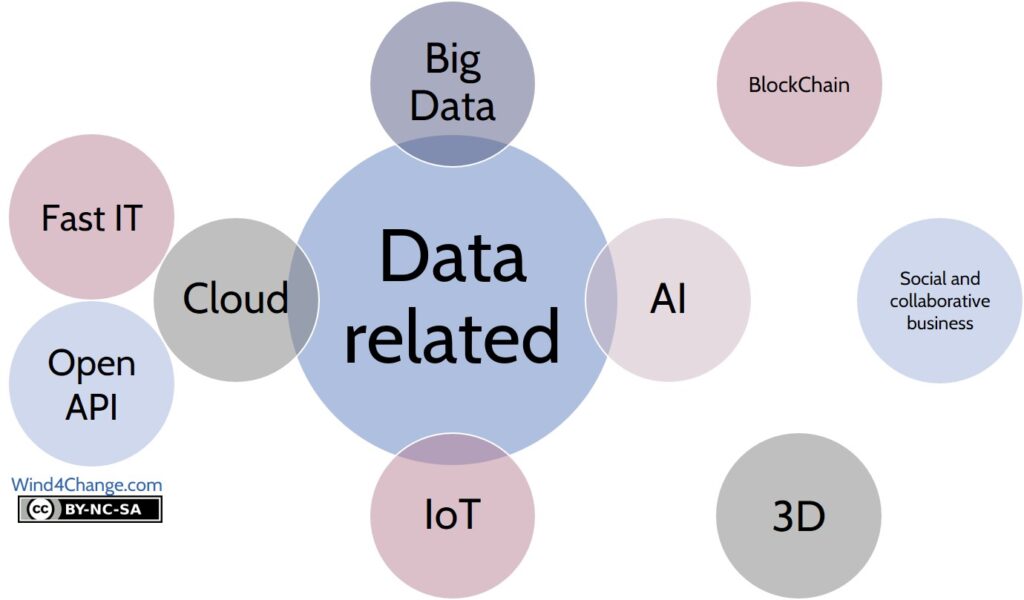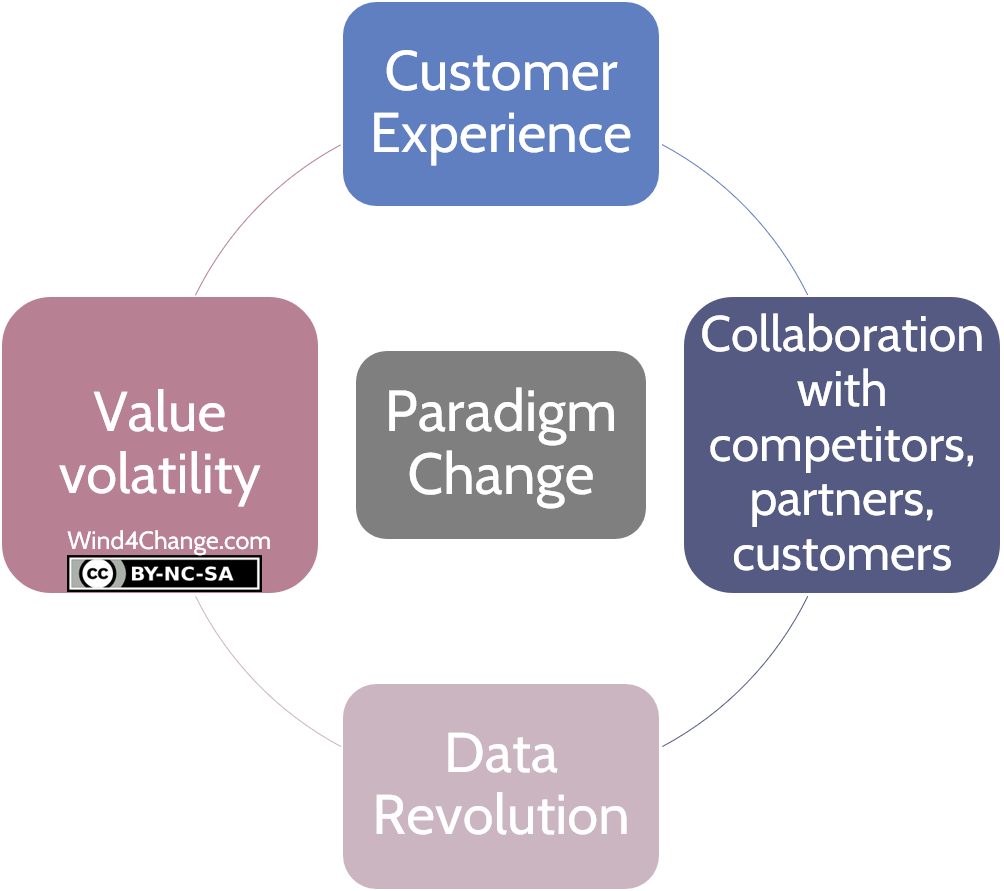In this last post of a serial of 6, we will review how agile fits in the picture of the new disruptive technologies and the changes of paradigm with digital disruption. And, how agile supports the Digital Revolution and the limits where dedicated actions are required.
- New Digital disruptive technologies
- The four changes of Paradigm in Digital
- Change of paradigm: from Product to Customer Experience
- Change of paradigm: new way of collaboration with competitors, partners and customers, the Business Platform Model
- Change of Paradigm: the Data Revolution
- Change of paradigm: the Value Volatility
- What’s next? Learn more about Digital, the new paradigms and the disruptive technologies
- Do you want to learn more on how Agile fits in the Digital transformation picture? Here are some valuable references
New Digital disruptive technologies

Has we have seen, part of the Digital transformation is the fast emerging and disrupting technologies changing the rules of established markets.
Agile is technology agnostic. But Craftsmanship and DevOps that closely connect to Agile, cover some of these new technologies: Fast IT and Open API. In addition, Agile native environment is software that is an increasing part of products.
But Digital transformation is not just the deployment of new technologies, as we have reviewed with major Paradigm shifts.
The four changes of Paradigm in Digital

We have seen that Digital is more than the emergence of new disruptive technologies. It also involves a change of paradigms. There are 4 of them:
- From Product to Customer Experience
- From binary relationships with other companies either competition or collaboration to coopetition. In addition, interactions with and between customers change to Network collaboration.
- From Data as planned and segregated inputs to Data everywhere and critical to customer journey and to empower intelligence of products
- From Stable Value to Volatile Value
Let’s review how Agile supports theses changes of Paradigm.
Change of paradigm: from Product to Customer Experience
In Agile DNA
Agile with its traditional frameworks like Scrum, delivers more than features: outcomes. The why in the format of the user story is a good example: “As a User I want to feature so that purpose/why“.
In addition, Design Thinking and Outcome Driven Innovation clearly focus on the User Experience and the expected outcomes in all its dimensions, emotions included. As a matter of fact, Agile is by nature a customer-centric approach.
For more details about this aspect of Agile, check my post about the innovation process.
Point of attention with Agile and Digital
In order to make sure that the full customer journey is properly covered, it is important for the Product Owner to double check that the needs of all contributors to this customer journey are taken into account: subcontractors, partners and suppliers…
Change of paradigm: new way of collaboration with competitors, partners and customers, the Business Platform Model
In Agile DNA
Agile leverages collaboration and the collective intelligence. Indeed, Agile prefers network interactions over hierarchical and point to point relationships. So, Agile is ready for these new type of cooperation.
Change of Paradigm: the Data Revolution
In Agile DNA
Agile is not especially a lever regarding this change of Paradigm on Data, except that agile is information oriented and values feedback from customers and exchanges with contributors.
Changes in Agile to support Digital transformation
Integration of the Data dimension as such in the Agile framework is critical. Therefore, the Product Owner should take into account Data inputs from customers, subcontractors, partners and suppliers. This is an input for the product design and build with the related customer experience.
Change of paradigm: the Value Volatility
In Agile DNA
This change of Paradigm is the one where Agile is the main lever. Indeed, Agile is fast and adaptive in its DNA and it fosters learning and innovation to create, design and deliver differentiating features to the market. So, with Agile, the full product life-cycle integrates learning and adaptability to change based on quick experiment and validation of assumptions on core elements. To illustrate, this passes by prototypes to incremental value delivery with Minimum Viable Product (MVP) and Minimum Marketable Feature (MMF).
Some example on how today Agile makes it possible to run experiments for assumption validation, in design and also in deployment phases:
- Rapid experimentation can involve continuous A/B and multivariate testing that are common in Amazon and Google.
- Prototypes to explore new products: like Intuit testing the concept for a mobile finance app with a manager holding reams of paper and a dumb phone.
- Careful piloting and rollout, for instance like Starbucks with its new store features.
Point of attention with Agile and Digital
Early phases of product design are a point of attention. Traditionally in agile organizations, Agile is more mature in recurrent mode when the product is established than in creating a new product where design thinking and outcome driven innovation are required. Surely, need for business involvement is usually much higher in these early phases with Business/IT ratios nearly inverted. Therefore, these design phases should be reinforced to prepare a Digital transformation.
Changes in Agile to support Digital transformation
Integration of hardware and IA/Data dimensions
The convergence of hardware and software, the emerging Artificial Intelligence require to take all these dimensions into account all together. Really, this is the key to better value and faster time to market, so the company can beat the competition.
Integration in addition to IT and related business of all contributors to develop and build the product
This necessitates a tighter integration of software, hardware, AI/Data development for design, engineering and manufacturing with other product and business teams. So, there is a need for early validation of customer and business value. This implies connecting designers, engineers, data scientists, marketers and partners with all needed competencies to develop the product. It is not just during the design phase. But all over the product life-cycle to continuously inject improvement into digitally and software-driven devices.
Great impact is at stake: some amazing example on how Agile can accelerate product development
Tyre maker Michelin has cut its time to market down from 7 to 3 years. And the French electrical and industrial equipment maker Schneider has shortened its product innovation cycle from 3 years to just 8 months. And it is working at reducing it still further.
What’s next? Learn more about Digital, the new paradigms and the disruptive technologies
Check my other posts on Digital and the new paradigms:
Check my post about the disruptive technologies that are referred to.
Do you want to learn more on how Agile fits in the Digital transformation picture? Here are some valuable references
- Building the Agile Business through Digital Transformation
- The website of the author, Neil Perkin.
